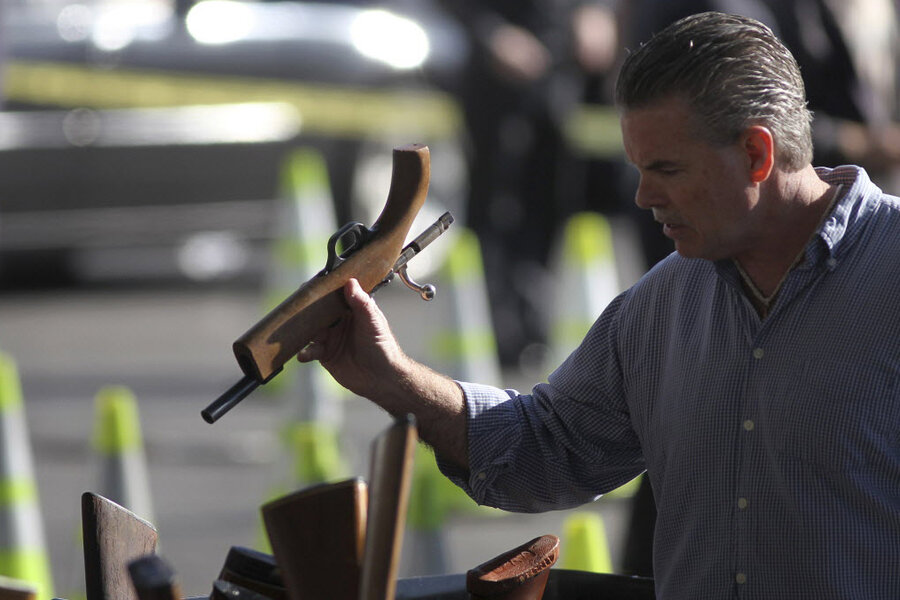Los Angeles collects most guns ever, in post-Newtown buyback event
Loading...
The city of Los Angeles, one of several municipalities to hold a gun buyback event since the Dec. 14 mass shooting in Newton, Conn., collected more than 2,000 firearms – a record, police officials reported Thursday.
Los Angeles had moved up the date of its no-questions-asked gun turn-in with the hope that the Newtown tragedy would prompt residents to surrender some firearms, thereby reducing the number of guns in circulation. Mayor Antonio Villaraigosa said the city would gave $100 to $200 gift cards in exchange for each gun recovered.
At a press conference Thursday, police officials said they collected 2,037 firearms, surpassing the 1,673 guns collected last year.
Los Angeles is the largest city to host a gun buyback day since the Newtown shootings, which killed 20 schoolchildren, six school faculty and staff, and the gunman's mother. Smaller cities have made similar calls for guns, including Evanston, Ill., a suburb of Chicago, which collected 45 firearms, mostly handguns, in exchange for cash. Last Saturday outside Miami in Opa-Locka, Fla., 100 firearms were collected, almost double the total collected in a similar buyback event in June.
A buyback event is planned Saturday in Bridgeport, Conn. – about 30 miles from Newtown – and city officials say repeat dates are scheduled every Saturday in January.
Forty-one members of the US House of Representatives, all Democrats, are calling for a federal gun buyback program. The letter to House Speaker John Boehner (R) and majority leader Nancy Pelosi (D), co-written by US Reps. Gerald Connolly of Virginia and Ted Deutch of Florida, asks for $200 million to fund a program that “could remove as many as 1 million guns from our streets.”
“The murder of 20 youngsters and five educators in their classrooms has galvanized the public’s desire for immediate action, and partnering with the States on a nationwide gun buyback program is a modest, common sense start,” they wrote.
Some in the crime prevention community, however, are skeptical that buyback programs do much to reduce homicide counts.
A 2004 report by the National Academy of Sciences on gun violence finds the strategy to be “flawed,” because the types of guns that tend to be turned in are “old, malfunctioning” or “owned by individuals who derive little value from the possession of guns,” such as people who have inherited guns but are not gun enthusiasts themselves.
The report also concluded that the guns turned in are unlike those used by criminals and that there is no link, supported by data, between buyback programs and reduced gun violence.
Among the guns collected in Los Angeles on Wednesday, police say, were 901 handguns, 698 rifles, and 363 shotguns. Seventy-five firearms were assault-style weapons, including a camouflage Bushmaster AR-15, the same kind of gun used in the Newtown massacre.
Police in Chicago recovered a similar number of assault-style weapons during a buyback event in June. They took custody of 5,500 guns – fewer than the 2007 record of 6,700. Chicago this year is reeling from a spike in gun violence; by next week, it is likely to have recorded at least 500 homicides, making it one of the most violent cities in the US.
Whether buyback programs can prevent mass shootings is debatable, but some suggest that they can be an effective tool for reducing the risk of gun violence inside the family home, where the majority of violent crimes took place between 2004 and 2008.
Almost 2 percent of children ages 17 or younger were victims of violent crime inside the home in 2010, according to data released this month by the US Bureau of Justice Statistics (BJS). Among adults, women are the most likely victims. Between 1993 and 2011, women living in households made up of an adult female with children experienced intimate partner violence at a rate 10 times that of households made up of married adults with children, the BJS data show.
Violent crime is defined as rape, sexual assault, robbery, aggravated assault, and simple assault. A firearm is the weapon of choice in the majority of nonfatal violent crimes, says the BJS.
When it comes to reducing crime inside the home, buyback programs “can’t hurt,” says Tod Burke, who teaches criminal justice at Radford University in Radford, Va. “Oftentimes the guns are used against the owners, or a child picking up a gun in a home accidentally shoots someone. Guns are often a weapon of convenience, and if we can make them a little less convenient, all the better,” he adds.
Guns stored at home also have a higher chance of being stolen than are guns stored elsewhere, according to BJS data. About 1.4 million guns, or an average of about 232,400 a year, were stolen during home burglaries between 2005 and 2010.








